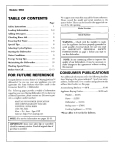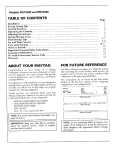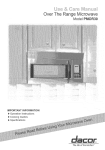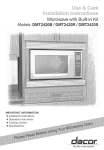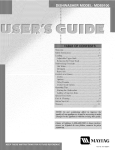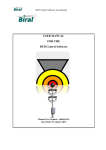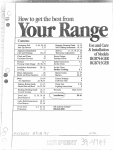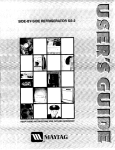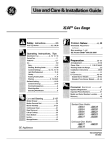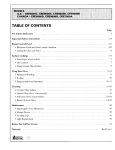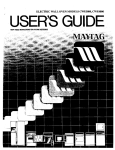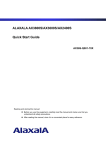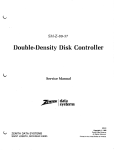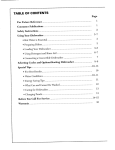Download Maytag CRE9900ACE User`s guide
Transcript
TABLE OF CONTENTS
Page
For Future Reference
................................................................................
1
Consumer Publications ..............................................................................
1
Important
Electronic
Safety Instructions ..................................................................
Clock and Oven Control ........................................................
2-4
5-6
• Setting the Clock and Timer ..............................................................
Surface Cooking ..........................................................................................
• Using Your Ceramic Glass Surface .....................................................
• Coot_vare Considerations ...................................................................
6
6-9
7-8
8-9
Using Your Oven ..........................................................................................
10-17
• Baking ..................................................................................................
11-13
• Roasting ...............................................................................................
14
• Broiling ................................................................................................
15-16
• Delay Start Oven Cooking ..................................................................
16-17
Care and Cleaning ......................................................................................
• Ceramic Glass Surface ........................................................................
17-21
17-18
• Self-Clean Oven ..................................................................................
18-19
• Range Cleaning Chart ........................................................................
Maintenance .................................................................................................
20-21
22-24
• Leveling Legs ......................................................................................
22
• Light Replacement .............................................................................
• Oven Door ...........................................................................................
22
23
• Storage Drawer ...................................................................................
23
• Fuses (Canadian Ranges Only) ..........................................................
Before You Call for Service .......................................................................
23
24
Warranty
25
.......................................................................................................
FOR FUTURE REFERENCE
Congratulations on your choice of a Maytag
electric range! As )vu use your new range we
know you will appreciate the many features that
provide excellent performance, ease of cleaning,
convenience and dependability,
For furore reference we suggest you retain this
manual after recording the model number and
serial number of this electric range in the spaces
provided. This information can be found on the
data plate located on the frame around the
New features have dramaticaliy changed today's
cooking appliances and the way we cook. It is
therefore very. important to understand how
your new electric range operates before yon use
it. On the fnllo_ng pages you will tlnd a wealth
of information regarding all aspects of your
range. By following the iustmetions carefully;
vou will be aisle to full), e_ajoyand properly
maintahl your Ma)_ag range and achieve
excellent results x_dththe food yon prepare.
storage drawer.
ModelNumber
]
Serial Number
J
DatePurchased
Should yon have any questions about using your
Ma?ntagelectric range, call or write us. Be sum
IMPORTANT:
Retain the proof of purchaSe
to prox4de
your
range.the model and serial nnmbers of
documents for warranty Service.
CONSUMER EDUCATION
MAYTAG COMPANY
WARNING - Check with the Installer
make sure the appliance
has been
grounded to avoid possible electrical
ONE DEPENDABILITY SQUARE
NEWTON, IOWA 50208
(515) 791-8911
(Mon.-Fri., 8 am-5 pm CST)
shock. Be sure you read the
IMPORTANT SAFETY INSTRUCTIONS
on page 2 before you start to use
this range.
CONSUMER
to
PUBLICATIONS
For more intbrmation, order the following booklets from Maytag at the prices indieated. Send your name,
address, booklet title, form number and payment to: Consumer Edneation Dept., Maytag Company, One
Dependabili_" Square, Newton, IA 50208. Allow 4-6 weeks for deliver.
Cooking Made Simple -272YG ...............................................................................................
50¢
Taking the Lid Off Cooktop Choices - 298YG ........................................................................
50¢
Before You (:all (avoiding unnecessary service calls)
206YG .............................................. 50¢
Appliance Buying Guides .........................................................................................................
Washer -- 211YG
50¢ EACIt
D_er -- 212YG
Dishwasher
213YC
Electric Range
'214YG
Cas Range -- 215YG
Refrigerator -- 276YG
PAG E
IMPORTANT
SAFETY INSTRUCTIONS
covers all electric cooking appliances. You may
find some information that does not pertain to
your particular appliance. Please review this
section before using your cooking appliance,
on Grease Fires:
Smother the fire or
flame or use a dO,
chemical or foam-type
The following instructions are based on salbty
considerations and must be strictly {bllowed to
extinguisher, if
a_ailable, or sprinkle
eliminate the potential risks of fire, electric
shock, or personal injury.
hea_4ly with baking soda.
Use Dry" Potholders Only:
Proper
potholders on hot surfaces may result in burns
from steam. Do not let the potholder touch the
hot heating elements. Do not use towels or other
bnlky cloths.
Installation:
Be sure your appliance is
properly installed and grounded hy a qualified
technician,
NEVER USE YOUR APPLIANCE FOR
WARMING OR IIEATING THE ROOM.
Moist or damp
Surface Cooking Units - Use the Proper Pan
Size: This appliance is equipped with one or
more surface elements of different sizes. Select
utensils ha_ng flat bottoms large enough to
cover the surface element. The use of
undersized utensils will expose a portion of the
heating element to direct contact and may result
in the ignition of clothing. The proper
relationship of the utensil to the element will
also improve efficiency.
Storage Above the Range: To eliminate the
hazard of reaching over hot surface elements,
cabinet storage should not be provided directly"
above a unit. If provided, storage should be
limited to infrequently used items that can be
safely stored in an area subjected to heat.
Temperatures may be unsafe for some items
such as volatile Iiquids, cleaners, or aerosol
sprays. If cabinet storage is provided, installation
of a range hood that projects at least 5 inches
beyond the bottom of the cabinet will reduce the
hazards associated with such storage,
Never Leave the Surface Units Unattended
Wear Proper Apparel:
Make Sure the Drip Bowls Are in Place:
The absence of these bowls dining cooking m_,
...._
at High Heat Settings: Boilovers cause
smoking and greasy spillovers that may ignite.
_
garments should nexer
Loose-fitting
hanging
be worn whileorusing
the _
appliance.
_"__
]
subject
the wiring
or the components
nnderneath
to damage.
Protective Liners: Do not use aluminum toil
User Servieing: Do not repair or replace any
pait of the appliance unless specifically
recommended in the User's Gnide. All other
to line the surface unit drip bowls or the oven
bottoms, except as suggested in the User's
Guide. The improper installation of these liners
servicing shonkt be referred to a qualified
technician. Ahvays disconnect the unit or cut off
the power to the unit before any servicing,
may"result in a risk of electric shock or fire.
Glazed Cooking Utensils: Only certain types
of glass, glass/ceramic, ceramic, earthenware, or
Storage In, On or Near the Appliance:
Do
not store or use gasoline or other flammable
materials, vapors and liquids in the oven, near
the surface units or in the vicinity of this or any
other appliance. The filmes can create a fire
hazard or an explosion. Do not use the cooktop
or oven as a storage area for food or cooking
utensils,
other glazed utensils are suitable for range-top
ser_-iee without breaking clue to the sudden
change in tempcratuJ_.
Utensil Handles Should be Turned Inward
and Not Extend Over the Adjacent Surface
Units: To reduce the risk of bun_s, ignition of
flammable materials, and spillage due to
unintentional contact with the utensil, the
PAGE 2
•
utensil shonkt
be positioned so
and requires businesses to warn customers of
potentM exposures to sucb substances.
it is mined
Users of this appliance are hereby warned that
when the appliance is engaged in the self-clean
cvcle there may be some low-level exposure to
inward,
and
does
not extend
over tile
handle ofsurface
a
adjacent
Do Not Soak the Removable
elements,
Heating
Elements:
The beating elements should never
be immersed in water, hrnnersing an element in
water wonkl damage tlre insulating material
inside the element,
California
cause substances,
cancer or reproductive
harm,
some
of thetolisted
inehlding carbon
monoxkle. Exposure to these substances can he
minimized by properly venting the appliance to
the outdoors during the self-clean cycle.
Deep Fat Fryers:
Use extreme caution when
Use Care rWhen Opening the Oven Door:
Let any hot air or steam escape before removing
or repl'acing the food.
Do Not Heat Unopened Food Containers:
Tim build-up of pressure may cause a container
moving tim grease kettle or disposing of the hot
grease.
Prepared Food Warning: Follow the food
manufacturer's instructions. If a plastic frozen
fbod container and/or its film cover distorts,
warps or is other'Mse damaged during cooking,
immediately discard the fnod and its container.
The food could be contaminated.
to burst and result in
Do Not Touch the Surface or Oven
an iqjnI'y.
Keep the Oven Vent Duets
UNOBSTRUCTED;
(located under the rear
element; the rear comer of the cooktop;
between the oven door and the control panel of
wall oven nr on tile haekguard) Blockage of the
vent prevents the proper oven air circulation and
will afl_ct the oven performance. Avoid touching
the oven vent area while the oven is on aml for
several minutes after tile oven is turned off.
Elements, Areas Near the Elements or the
Interior Surfaces of the Oven: The elements
may be hot even though they are dark in color.
The areas near tile surface elements and the
interior surfaces of the oven may become hut
enough to cause burns. During and after use, do
not touch or let clothing or other flammable
materials contact tile heating elements, the areas
near elements or the interior surfaces of oven
Some pm_s of the vent and the surrounding area
may become hot enough to cause bums.
until they have had sufficient time to cool.
Among these areas are the eonktop, the surfaces
facing tile cuoktnp, tile oven vent opening and
Placement of the Oven Racks: Always place
the oven racks in the. desired location while the
oven is cool. If the rack nmst be nmved while
hot,
avoid contact of the potholder
with use
tile care
oven toelement.
Ventilating Hoods: Clean ventilating hood
frequently, to prevent gTease from aceulnulatilrg
on it or its filter. When "flaming" tbnds under tbe
hood, or if a boilover results in an open flame,
immediately turn offthe hood's ventilating fan.
The fan can cause flame to spread. After flame is
thoroughly extinguished, tile l;an may be turned
on to remove unpleasant odor or smoke,
Important Safety" Notice and Warning: The
Califbmia Safe Drinking %hter and Toxic
Enforcelneut Act nf 1986 (Proposition 65)
requires the Governor of California to publish a
list of substances knux_ to the State of
the surt_tces near this opening, the oven door,
and the oven xvindo_ Also, do not allow
alnmimlm foil, meat probes or any other metal
object (other than a pan on a surface element) to
contact the heating elements.
Anti-Tip Bracket Warning: To reduce the risk
of tipping of the appliance from nmlsual usage or
by excessive loading of the oven door, the
appliance must be secured by a properly
installed anti-tip device. To check if the device is
installed properl); use a tlashlight amt look
underneath the range to see that one of tile rear
leveling legs is engaged in the bracket slot.
When removing the appliance fur cleaning, be
sure the anti-tip de,-ice is engaged when the
range is replaced. The anti-tip de_qce secures tile
rear leveling leg to the floor when properly
engaged.
PAGE 3
Additional Infortnation:
After the appliance is
installed, be certain all packing materials are
removed from tile appliance before operating
the unit. If the appliance is installed near a
window, take steps to prevent curtains from
blowing over the surface elements creating a fire
On some models, a fan should be heard during
the self-clean cycle. If not, cancel the clean cycle
and call a qualified technician before selfcleaning again. (Refer to the Table of Contents
for location of self-clean instructions and fan
information.)
h_ard.
Care should be given to the location of
appliance. Be sure the floor covering under the
appliance, the walls adjacent to the appliance,
the cabinetry adjacent to the appliance, and
other materials adjacent to tile appliance can
withstand prolonged heat. This is a heavy
appliance and can settle into soft floor coverings
such as cushioned vinyl. Use care when moving
the range on this type of floor covering,
Ceramic Glass Cooktop: Do not cook on a
broken cooktop. If the cooktop should break,
cleaning solutions and spillovers may penetrate
the broken cooktop and create a risk of electric
shock. Contact a qualified technician
immediatel}_ Clean the cooktop with caution. If"
a wet sponge or cloth is used to wipe spills on a
hot cooking area, be careful to avoid steam
bm'ns. Some cleaners can produce noxious
fmnes if applied to a hot surface.
Oven Door: Do not place excessive weight on
an open oven door or stand on an open oven
door as, in some cases, it could canse the range
to tip over, breakage of the door or serious injuv,
Circuit Breaker or Fuse: Locate and mark
Do Not Leave Children Alone: Children
should not be left alone or unattended in an area
where an appliance is in use. They should never
be allowed to sit or stand on any part of the
appliance. CAUTION: Do not store items of
the breaker or fuse. Never replace a blown fuse
or reset a breaker until you know what has
caused the problem. Ahvays replace a blown fuse
with one of the correct amperage - do not use a
substitute,
Controls: Turn offthe controls at the
interest to children in the cabinets above an
appliance or on the backguard of a range.
Children climbing on the
appliance to reach items
_-----_ t_i
could be seriously injured.
Children must be tanght
completion of a cooking operation,
Self-Clean Oven: Do not clean the door
utensils
that
the in
appliance
or on it can
and be
hot. Children should be
gasket. The door gasket is essential for a good
seal. Care should be taken not to rob, damage,
or move the gasket. Do not use any oven
cleaners or an oven liner protective coating of
any kind in or around any part of the self-cleazl
oven. Cle_m only the parts listed in this booldet.
Before self-cleaning the oven, remove the
tanght that an appliance is
not a toy. They should not
be allowed to plav with the
controls or other parts of
the unit.
broiler pan, tile oven racks, and other utensils,
CAUTION: DO NOT LEAVE FOOD OR
COOKING UTENSILS, ETC., IN THE OVEN
DURING THE SELF-CLEAN CYCLE.
PAGE 4
THESE
[[
iN CASE OF FIRE!
1
li Turn Offthe app!iance and the _entilating hood:
r or baldng
ATTENTION: NE LAISSERAUCUN
ALLVIENT, USTENSILE DE CUISINE, ETC.,
DANS LE FOUR DURANT LE CYCLE
D'AUTONETTOYAGE.
SAVE
---",_-"_
INSTRUCTIONS
RANGE CONTROL PANEL
ELECTRONIC
CLOCK AND OVEN CONTROL
The electronic dock and oven control on your
Maytag range is used for the time-of-day clock,
timer, bake, broil, delay- start and self-clean
functions. A beep will sound each time a
function Fad is pressed. At the end of an
operation, consecutive beeps will sound.
Cancel Pad
Press this pad to cancel all operations except the
time-oLday eloek and timer. If you are ever
unsure if you've programmed the control
cx_rrectly7press tile CANCEL Fad and start over.
The display on the control x_dllblink when power
is first supplied to the range or if there is a power
failure. Once the time-of-day clock has been set
(see Setting the Clock, page 6), the display will
stop blinking.
Set
Turn
time
used
NOTE: The electronic eontr61 is equipped
with a self-diagn0st! c feature £or se_ee
ONLY. If a fault code (F pI_ a number, :eX:F!)
appears in the diSp!_" alo_g,Mtb a ContinuOUs
beeping sound, press the CANCEL pad: S_
Bel0re Yon Call for Service (page 24) if the
The timer can be set from 5 seconds to 9 hours,
50 mimltes. It will count down by minutes (when
set for 1 hour or more time) or seconds (when
set for less than 1 hour). See page 6 for
instructions on setting the timer.
fault code reappears in t}le display: ,
Clock Pad
Use this pad to set the time-of-day clock. For
instructions to do this, see page 6.
:i
The following pads and knobs are found on your
Maytag electronic clock and oven control:
Knob
this knob in either direction to enter tbe
or temperature desired. This knob is also
to seleet Hi or Lo broil.
Timer
Pad
PAGE 5
Youmayalsopress
thispadtorecallthecurrent
time-of-day. For example, if the timer is
counting down in the display, press the CLOCK
pad to return the current time to the display.
The timer will continue to count down and a
signal will sound when the time expires,
Cook
Time / Oven Stop Pads
These pads are used to program the oven to start
and stop automatically, either immediately or at
a later time. For detailed information on using
Delay Start, see pages 16-17.
Self-Clean
Pad
This pad is pressed to set the oven for a selfclean cycle. See pages 18-19 for detailed
information on using the self-dean feature,
Broil Pad
Two heat selections are available for broiling Hi and Lo. See pages 15-16 for more broiling
information.
SU RFACE COOKING
Using the Electronic
Controls
Your range is equipped with touch control pads
that allow you to select a wide choice of heat
settings from Low to High.
To operate the electronic controls: Press tim
ON/OFF pad to turn the surface cooking area
on and then press the • or • pad to select a
numbered setting or a setting in between. Wben
first turned on, pressing the • pad will select the
lowest heat setting and pressing the • pad will
select the highest heat setting. The beat level can
be changed at any time by pressing the • or •
pad. A signal will be heard each time either pad
is pressed and the display will light to identify
the heat setting selected. Afiter a cooking
operation, turn the cooking surface off by
pressing the ON/OFF pad.
Oven Temp Pad
The bake temperature is set by pressing this pad
and turning the SET knob. Additional baking
information can be found on pages 10-13.
Setting the Clock and Timer
Clock
To set the time-of-day clock:
i. Press the CLOCK pad once. The word Time
will light in the display.
2. Tnrn the SET knob to the correct time-of-day.
After one minute, the word Time will
disappear and the dock will advance.
Suggested
Heat
Settings
Timer
To set the timer:
The type of food being cooked determines the
heat setting. If too hot, food may boiI over, eggs
may be tough, meat mav be charred, sances may
scorch and fat can spatter.
1. Press the TIMER pad once. The word Timer
will light in the display,
2. Turn the SET knob to the desired time. For
Keep in mind tlmt food will not cook any faster
at a higher setting than that which will maintain
a gentle boil (water boils at the same
example, turn the display to :05 tbr five
seconds or to 5:00 for five minutes. The timer
will sta_ automatically. The signal will beep
when the time elapses. The time-of-day will
appear in the display.
To cancel the timer, turn the SET knob to :00, or
press and hold the TIMER pad until it beeps
and the time-of-day appears,
temperature, whether boiling vigorously or
gently). However, if too high a setting is used,
food may bum on the bottom before it is
completely cooked.
Press the eleetronie eontrol pad to select the
desired heat setting. If in doubt, it is better to
select a lower setting and increase to a higher
one later if needed. It will take longer for the
PAGE 6
cooking surface to cool to a lower temperature
than to heat up to a higher temperature,
Use the following chart as a guideline until you
become
moreinfamiliar
your new
range,
Information
the chartwith
is based
on the
use of
heavy gauge aluminum coolc_vare.Other utensil
materials may require a different heat setting }'or
the same cooking operation. Lower the heat
setting if using stainless steel or cast iron
utensils. \Ve suggest that yon experiment to find
the heat setting that best suits your particular
cooking needs. For more information on
cookavare, see 8-9.
Setting
Uses
HIGH
To bring liquid to a boil, blanch or bring
up pressure in a pressure cooker.
Always reduce to a lower heat setting
when liquids just begin to boil or food
begins to cook.
7
2"3
1
LOW
......
.........
NOTEiDu_ng
mayn6ti_ {_
sii_t bu_g
ih_ fir_{few _urs hf"_g _
_e ceramic g[_S e°°kt°p _mits
_0_ and a _ght Sm0ke B6th Of
h ing
To help keep the ceramic glass clean, be sure
the cooking area and utensil bottom are clean
and dry before use.
Hot Surface
Light
To maintain a fast boil for large
amounts of liquid.
Your ceramic glass range is equipped with a red
Hot Sure'tee Light that will turn on to indicate
To maintain a slow boil ibr large
amounts of liquid, for most frying,
that the cooking surface is hot. It will remain on
until the area has cooled.
To continue cooking uncovered foods,
for most slow frying, stewing, braising
or steaming,
After 30 minutes, the cooking surface may be too
cool to keep foods warm. However, the top may
still be too warm to touch. When the Hot
For long, slow cooking of covered foods
(simmering).
Surface Light tunas off; the top will be cool
enough to touch.
To keep foods warm before serving,
melt chocolate or butter.
Heat Retention
Whenever a cooking area is turned on, heat is
transferred through the cooktop to the utensil If
Using Your Ceramic
Surface
Cooking
Before using the eooktop for the first time, clean
it thoroughly as directed on the cleaning chart
on pages 20-21. This will protect the ceramic
glass surface and will guarantee a clean cooktop
when the elements are turned on.
of
To quickly brown or sear meat, for fast
cooking of non-protein foods (such as
vegetables or pasta).
6
When a cooking area is turned on, a red glow
from the coil element can be seen through the
ceramic glass surface. The red glow will cycle on
and off as the element cycles to maintain the
selected heat setting.
Glass
Areas
the utensil is in proper contact with the cooking
area, it will readily absorb heat. The area
surrounding the cooking area will remain cool
We suggest that you start with a lower heat
The four cooking areas on your Maytag range are
identified by permanent patterns in the ceramic
glass surface. There are two large (8-inch) and
two small (6-inch) areas. The cooking areas are
marked to help yon select an appropriately sized
utensil. The utensil should be centered over the
setting then gradually increase the setting until
you find the optimum setting. Believers are
more likely to occur if you sta_ out on High then
reduce to a lower setting. Do not wait for liquid
to come to a fifll boil before reducing the
temperature. If food is cooking too fast or if
design for maximum energy efficiency. If the
cookware extends more than two inches beyond
the cooking area, cooking times may be longer
and excess heat may be transferred to the
ceramic glass surface.
believers occur, remove the lid or take the
utensil offthe cooking area. Allow enough time
for the cooking area to adjust to the new setting,
then replace the utensil.
PAGE 7
The ceramic glass cooking area retains heat for a
Cookware
period of time after tim element has been tu reed
off. Put this residual heat to good use. Tuna the
element offa few minutes before the food is
completely cooked and use the retained heat to
Regardless of the cooking surface used, the
eookware material, construction and size can
play a large role in cooking performance. Proper
utensils will reduce cooking times, use less
energy, and cook food more evenly Optimum
complete the cooking,
Tips tO Protect
the
Considerations
Cooktop
cooking performance
Do not use glass utensils on the ceramic glass
can be achieved
when
heavy
fiat, smooth
utensils gauge,
with straight
sides bottom,
and tightmetal
fitting
lids are used. When selecting cookware,
consider the following things:
cooktop. Glass ceramic, earthemvare, heatproof
glass or glazed utensils may scratch the cooktnp
and are not recommended.
Construction
and Size
For best heat condnction from the cooking
surface to the utensil, use fiat bottuin utensils. To
determine the flatness of the bottom of a pan try
one of these tests:
Do not allow plastic, alnminum foil, sugar or
food with a high sugar content to melt onto the
hot eooktop since this can cause permanent
damage. If you accidentally melt these items to
the cooktop, remove the substance iminediately
while it is still hot using a razor blade scraper
held carefully with a potholder. Do not attempt
flmther cleaning until the area has cooled,
1. Ruler test: Place the edge of a nller across
the bottom of the utensil. Hold it up to the
light. Little or no light should be visible under
the rnler.
Do not slide metal or glass items across the
ceramic glass surface. They may damage the top.
Do not slide almninmn cookavare across the
cooktop. This may result in alunainum marks
which need to be removed promptly with a
recommended eooktop cleaner.
Disposable aluminum eookware, aluminum foil
or foil containers such as popcorn poppers are
not recommended for use on the ceramic glass
cooktop. They will leave metal marks and may
permanently melt onto the ceramic top if the
cooking area is turned on.
1
as
4
5
6
7
8
9
10
11
control
to High.
As the Ifwater
heats, obsei_/e
the bubble
forlnation.
the bubbles
are
uniform across the bottom of the utensil, it is
suitable }br use on most cooking surfaces.
Uneven bubble formation indicates poor
directly on the cooktop without a utensil or using
the top as a work surface or cutting board.
(such
3
fi. Cooking test: Put an inch of water into the
utensil. Place it on the cooktop and tnm the
To protect the cooktop, avoid cooking food
Do not nse a trivet or metal stand
2
a wok
ring) between the utensil and the cooktop. These
items can mark or etch the SUl_aceand affect
pan/cnoktop contact making it an inappropriate choice for ceramic glass.
cooking efficiency.
Match the size of the coo_vare to an element or
CANADIAN RANGES: A Ceramic glass
e_x)lctopwill not operate during a self-clean
cycle. This is normal,
srnaIler. Avoid using sluall cool_vare on a much
larger element or cooking area to reduce ener_,
loss.
Excessively
nmv lengthen
cooking
area that large
is thecookware
same diameter
or slightly
coo!dllg times and transfer excess heat to the
cooktop which could cause cracking or chipping.
PAGE 8
I
Material
Tile pan material determines how evenly and quickly heat is transferred from the heat source to the pan
bottom. Some widely used pan materials are:
Aluminum
Excellent heat conductor, Some tbod ,Mll cause it to darken or pit. Anodizing improves stain resistance.
Often used as a bottom coating to improve the heating of other pan materials,
Copper
Excellent heat conductor. Discolors easily, requires constant polishing. Often used as a bottom coating
to improve the heating of other pan materials.
Stainless
Steel
Slow heat eonductor. Develops hot spots and produces uneven cooking results. Durable, attractive,
easy to clean and stain resistant. Will distribute heat better if other metals (aluminum or copper) are
combined or sandwiched together as a bottom coating.
Cast Iron
Slow heat conductor. Cooks evenly once temperature
cleaning easier and to prevent sticking and rusting.
Glass or Ceramic
Slow heat conductors. Easy to clean. Not recommended for solid elements or ceramic glass surfaces.
Some types mW only be used in the oven.
Glass like substance fused to metal. Heating characteristics depend on base material (usually
aluminum, stainless steel, carbon steel or cast iron). Available in colors and easy to clean.
Porcelain-Enamel
is reached.
Ileaxy. Needs seasoning to make
Note; Some brands of metal, smooth bottom eoo_vare that generally perform well on all types of ranges are Farberware,
Magnalite, Revere Ware, Wearever, TEa], and smooth bottom Club Aluminum °.
°Brand names are the trademarks of respective manuf:acturers.
Canning
For more information on canning procedures,
Acceptable water-bath or pressure canners
should not be oversized and must have a flat
contact your local counW extension office or one
of the following companies who specialize in
bottom. The following are not recommended:
home canning:
canners with ridged bottoms, oversized canners
(two inches larger than the cooking area) or a
very large canner that rests on two cooking areas.
When canning, use the High setting just until
* Ball Corporation
Consumer Affairs Department
345 South High St.
Muncie, IN 47305-2326
the water comes to a boil or pressure is reached
in the pressure canner, then reduce to the lowest
° Kerr Glass Manmaaetnring Corporation
Consumer Products DMsion
heat setting that maintains the boil or pressure.
Prolonged use of the High setting, or the use of
incorrect canning utensils will produce excessive
heat. Excessive heat can cause permanent
damage to the range.
1840 Centmy Park East
Los Angeles, CA 90067
PAGE 9
USING YOUR OVEN
EveJy oven has its own characteristics. You may
find that tlle cooking times and temperatures
you were accustomed to with your previous
range may need to be altered slightly with the
new range. Compare your recipes with the
baking chart on page 12 or refer to a reliable
cookbook
proper
It isthis
normal to for
notice
somerecommendations.
differences between
appliance and your old one.
Setting
the Controls
To remove: Be sure the rack is cool. Pull the
rack straight out until it stops. Tilt the Front end
up and continne pnlling the rack out of the oven.
To replace: Tilt the front end of the rack up
and place the rack between the rack snpports.
Slide it back until it clears the lock-stop position.
Lower the front and slide the rack straight in.
Pull the rack out to the lock-stop position to be
sure it is positioned correctly and then return it
to its normal position.
To set your oven For baking or roasting:
Rack
1. When cool, position the racks in the oven
according to what you are baking,
It is important that air can circulate freely' within
the oven and around the fbod. To help insnre
2. Press OVEN TEMP pad. Bake 000 ° will
this, place food in the center of the oven rack.
Allow two inches between the edge of the
utensil(s) and the oven walls. If cooking on two
racks, stagger the food to insnre proper airflow.
appear in the display',
3. Turn the SET knob to the desired oven
temperature. The temperature reading will
increase by 5° increments up to 550°. The
word On will light in the display and the
temperature display will rise in 5° increments
while the oven is preheating. Allow 10-15
minutes
for preheating.
4. Place the food in the center of the oven,
allowing a minimum
of two inches between
the utensil(s) and the oven walls,
Positions
Do not attempt to change the rack positions
when the oven is hot. Use the following
guidelines when selecting the proper rack
position:
Rack 1:
(lowest
position)
Used for roasting large cuts of meat and
large poultD', frozen pies, souffles, angel
food cake, or loaves of bread.
Rack 2:
Used
large
cakes
pans)
Rack 3:
Used for most baked goods on a cookie
sheet or jelly rollpan. or frozen
5. Cheek the food for doneness at the minimum
•
time
given
in the recipe.
_
Cook
y
hmger
• •
it
necessary: Turn the oven off by pressing the
CANCEL pad. Rmnove food from the oven.
Oven Vent
The oven vent is located on the back panel.
When the oven is in use, this area may feel warm
or hot to the touch. To prevent problmns, do not
block the vent opening in any way.
Oven Racks
The two owm racks are designed with a loek-stnp
edge to keep the racks from coming completely
out of the oven when there is food placed on
them.
PAGE 10
for roasting small cuts of meat,
casseroles, baking ]oa_es ofhread,
(in either tube. bundt, or layer
or two rack baking.
(raiddle
position)
eomenience foods.
Rack 4:
Used for most broiling and two-rack
haking.
Rack 5:
Used tbr some broiling.
(highest
position)
Never place pans directly on the oven bottom.
Do not cover an entire oven rack with aluminum
foil or place foil directly under a utensil. To catch
spillovers, cut a piece of foil a little larger than
the pan and place it on the rack below the
utensil.
Preheating
Baking
Preheating is necessary for proper baking resuJts.
It is not necessa_- fbr broiling or roasting. Allow
tile oven te heat until the desired oven
General
temperature is reached as shm_l in the clock's
display (this will take approximately 10-15
Baking
Tips
Baking results will generally be best when you
nse tested recipes from reliable cookbooks.
mimltes),
Follow the directions to the letter. Be sure to use
fresh ingredients, measure carefully; mix as
instrncted and use the recommended pan size.
Selecting a temperature higher than the desired
temperature will not preheat the oven any' t:aster,
In fact, this may have a negative effect on baking
results,
Be sure to preheat the oven if the recipe calls for
this (usually done for breads, cookies and
biscuits). See the previous section for more
information on preheating.
Oven Light
Must recipes provide minimnm and maximum
The oven light automatically comes on whenever
the oven door is opened. When the door is
closed, push the rocker switch marked OVEN
LIGHT on the control panel to turn it on or oft_
baking times such as "bake 85-45 minutes". Do
net open the oven door to check the progress
nntil the minimum time has elapsed. Take care
not to allow the o_en door to slam shnt.
Panel Light
The pane] light is turned on by pushing the
rocker
marked
PANEL
LIGHT
on the
control switch
panel and
holding
it in the
depressed
position until the fluorescent light comes on. It
may be turned off by depressing the other side
of the switch.
IMPORTANT:
DO not move the oven door
} 'latch to the right during broiling or baking. The
/ range door maylock and will not unlock until
[ the oven cools.
...............
Utensils
The finish on baking utensils determines tbe
amount of browning. Colored, glass or dark,
rough, dull utensils absorb heat, resulting in a
browner, crisper crust. Use this _1)e for pies or
breads. For lighter, more delicate browning, use
shiny or smooth ntensils that reflect heat. These
are ideal _br cakes and sngar cookies.
When baking iu g/ass utensils, lower the
recommended temperatnre by 25°F. (This is not
necessa D, when baking pies or casseroles.)
The same rnle applies when nsing a colored
porcelain pan.
Alxx%vsuse the pan size recommended in the
recipe. Many pans have the measurements
marked on them. lfthere are no measurements,
measure the inside width and length of the pan.
PAGE 1
Baking
Chart
You may find these guidelines helpfill when comparing the baking times, temperatures
positions of commonly baked foods.
Product
Cake
& Type
Pan Size
Rack Position °
Choeolate, two ]_-ers
Yellow, two layers
white, two layers
Bundt
9"
9"
9"
tube
2, 3 or 4
2, 3 or 4
2, 3 or 4
I or 2
350 °
350 °
350 °
350 °
30-35
30-35
25-30
35-45
2, 3 or
2, 3 or
1
2, 3 or
2, 3 or
350 °
350 °
375 °
325 °
375 °
15-20
20-25
30-40
40-50
30-35
Cupcakes
Sheet Cake
Angel Food
Pound Cake
Snacking Cake
Pies
Two Crust
Fnfit, fresh
Fruit, frozen
One Crust
Custard, fresh
Pie Shell
15" x 10"
tube
loaf
8" x 8"
Temperature
and oven rack
4
4
4
4
°F
Time °*
9"
9"
2, 3 or 4
1
4000-425 °
400 °- 425 °
35-55
45-60
9"
9"
2, 3 or 4
2, 3 or 4
350 °
400 °
35-40
8-12
or 4
or 4
or 4
or 4
350°-375 °
350°-375 °
350°-375 °
350 °
8-12
8-12
8-12
30-40
loaf
1 or 2
2, 3 or 4
375 °
3750-400 °
30-40
15-20
loaf
2, 3 or 4
350 °
45-60
350 °
400°-450 °
400 °
400°-425 °
400 °
4(1
15-30
10-20
10-20
15-25
Cookies
Chocolate Chip
Peanut Butter
Sugar
Brownies
2,
2,
2,
2,
S" x S"
Breads
Yeast
Loaf
Rolls
Quick
Loa[ nut or fruit
Gingerbread
Cornhread
Cornbread Muffins
Biscuits
Muffins
9" x 9"
S" x S"
2,
2,
2,
2,
2,
3
3
3
3
3
3
3
3
3
or
or
or
or
or
4
4
4
4
4
_The bottom rack position is #i.
°°Times are only approximate and may vary depending on the recipe used.
Temperature
Conversions
°Fahrenheit
200
250
275
300
325
350
375
400
425
450
°Celsius
100
120
140
150
160
180
190
200
220
230
PAGE 12
Common
Baking
If you have earefidly
may be helpful.
, Problem
followed
,
Slow baking
or roasting,
Problems
and Causes
the basic instructions
and still experience
Cause
poor results,
,
Cause
Baking or roasting time to()
short.
Too little leavening.
Overmixing.
Temperature too low.
Oven out of calibration.
Old oven out of calibration.
Incorrect use of aluminum foil.
Pan too large.
Oven temperature too high.
Baking time too long.
Pans too close to each other or
Oven not preheated,
i
,
oven wall.
i
Cakes are uneven.
i
Oven door opened frequently,
Too man), pans on racks,
Pans touching each other or
oven walls.
Batter uneven in pans.
J Oven temperature too low or
i
Improper measurement of
sugar, baking powder, liquid
,
or fat.
Old b_ddng powder.
Oven temperature too high.
Baking time too long.
.
baking time too short.
Range not level.
Undermixing.
Uneven
texture.
Too much liquid.
Undermixing.
Oven temperature too low.
Baking time too short.
Too much liquid.
Cakes hi_
middle.
•
in the
Cakes fall.
Temperature too high.
Baking time too long.
OvermLxing.
Too much flour.
Pans touching each other or
oven walls.
'
i
]
I
I
Cakes don't brown
on the boltom.
•
Cakes don't _0_IL
Batter overmixed.
Oven temperature too high.
Too much leavening.
Too much shortening or sugar.
Too much or too little liquid.
Temperature too low.
Old or too little baking powder,
in the center.
Pan too small.
Oven door opened frequently.•
Pie crust edges
' t co brown.
Temperature too high.
Pan too small.
Oven temperature too high.
Pans touching each other or
oven wall.
Edges of crust too thin.
wa]_ed.
Oven temperature
Using shiny u, et_d pax)s.
too low.
OvermL,:ing.
Too much liquid,
lneorreet pan size or too little
batter in pan.
Oven door opened too often.
Cakes, eooldes,
biscuits too brown
on the bottom,
Not enough shortening.
Too much baking powder.
Overmixing.
Oven temperature too high.
Oven not preheated,
Pans darkened, dented or
,
m
these suggestions
|
m! the _i_,
.....
crust
.....
....
t
Temperature too low at start of
baking.
Filling too juicy.
Using shiny metal pans.
Oven not preheated.
Pans touching each other or
oven wa]]s.
Using glass, darkened, waq?ed
or dull finish metal pans.
Incorrect rack position.
Incorrect use of aluminum foil.
PAGE 13
Roasting
Roasting is the method _br cooking large, tender
cuts
of meat uncovered, without adding
moisture.
General
Tips
Most meats are roasted at 325°F. It is not
Place the meat fat-side-up on a rack in a shallow
roasting pan. Placing the meat on a rack holds it
out of the drippings, thus allowing better heat
circulation for even cooking. As the fiaton top of
the roast melts, the meat is basted naturally,
eliminating tile need for additional basting.
The cooking time is determined
necessary- to preheat the oven. Place the roasting
pan on a rack which has been placed in either of
the two lowest rack positions,
by the weight of
the meat and the desired doneness. For more
accurate results, use a meat thermometer. Insert
it so the tip is in the center of the thickest part of
the meat. It shonkt not touch fat or bone.
Use tender cuts of meat weighing three pounds
or more. Some good choices are: beef rib,
ribeye, top round, high quality tip and romp
roast, pork leg and loin roast, veal and lamb leg,
shoulder roast and cured and smoked hams.
Remove the
tbermometer
the doneness
temperature
Season meat, if desired, either before or after
roasting. Rub into the surface of the roast if
NOTE: For more information on cooking meat I
and po_dtly; contact the USDA Meat and
added before cooking.
Roasting Chart (Thawed
Poultry Hotline at 1-800-535-4555.
Cut of Meat
Beef
Rib Boast (cut side dog,m)
Meats
roast from the oven when the
registers approximately 5°F below
wanted. As the meat stands, the
_dll rise.
I
Only)
Approximate
Weight
(pounds)
Oven
Temperature
in °F
(not preheated)
Internal
Temperature
Approximate
Roasting Time
(min. per pound) _
4 to 8
325 °
140 ° (rare)
160 ° (nledium)
2,5 30
30-35
Bib Eye Boast
4 to 6
325 °
140 ° (rare)
i60 ° (medium)
25-30
30 35
Loin Tenderloin Boast
2 to 3
4t10°
] 40 ° (rare)
20-25
Top Sirloin Roast
3 to 6
325 °
140 ° (rare)
160 ° (mediuln)
25-30
30-35
4 to 6
4 to 6
3 to 4
325 °
325 °
325 °
I60 °
160 °
160°
35-45
30 40
35-45
5 to 7
5 to 7
325 °
275 °
14(1°
160°
25-35
35 45
3-1/2 to 5
325 °
5 to 7
325 °
160 ° (medium)
17t1° (well)
160 ° (medium)
170 ° (well)
35 40
40 45
3(/-:35
35-4(t
3 to 5
4 to 6
325 °
325 °
170°
170°
40- 4,5
40-45
12 to 16
16 to 20
20 to 24
325 °
325 °
325 °
180%185 °
180 °-185 °
180 ° 185 °
/8-20
I6-18
14-16
3 to 8
2 1/2 to 3-1/2
4 to 6
325 °
375 °
375 °
180 °
185 °
185 °
30- 40
20-'24
20-25
Pork
Shoulder Blade Boast, Boneless
Shoulder Blade Roast
Loin Blade or Sirloin Roast
Ham, HaIf (fully cooked)
Ham, Half (cook-before-eating)
Lamb
Shoulder Roast Boneless
Leg, Whole
Veal
Rib Boast
S]loulder. Boneless
Poultry
Turkey, unstut't}ed_
Turkey, Breast
Chicken, Fryer
Chicken, Roaster
°Times are approximate and may vary depending on the type of range used.
**Stuffed turkeys take longer to cook; relSr to cookbooks tbr approximate
PAGE 14
time.
Broiling
The ttistance from the heat source depends on
tile thickness of the nteat. Thin cuts (3/4 to I
inch) should be placed 2-3 inches from the heat;
thicker cuts shonld be placed 3-5 inches from
the beat. Broil nntil tile top of the meat is
bro_xmed. It should be approximately half cooked
by the time tile top is bro'_md.
Broiling is a inethod of cooking used for tender
steaks, chops, hamburgers chicken, fish, and
some fruits and vegetables. The food is placed
directly under the element. The degree of
doneness is determined bv the distance between
the meat and the element, and the length of
I)roiling time.
General
If you plan to season tile meat, it is better to do
so after tile snr/ace has bro,mmd. Salt tends to
Tips
delay brnx_ming which can result in overcooking.
Broiling requires the use of tim broiler pan and
inseit supplied with yonr range. It is designed to
Salting before cooking also draws tile jnices out
of the meat, causing dDmess.
drain excess liquid and fi_taway From the cooking
snr}_ce to prevent spatters, smoke and fire.
Ne_er leave a soiled broiler pan in the oven after
broiling. Drippings might become hot enough to
For easier clean-up, line the broiler pan (bottom
ignite if exposed directly to the element.
piece) x_dtbalmninmn foil
x_dtha non stick vegetable
tile broiler pan insert with
prevents t_atFrom draining
Broil times may need to be increased if the
range is installed on a 20g-volt circuit.
and spray the insert
coating. Do not cover
alumimlm foil as this
into tile pan below
Setting
the Controls
The broiling element can be preheated,
howex er, do not preheat the broiler pan.
To prevent excessive spattering and smoking,
trim any, excess |:at From the {neat. Increasing the
1. BeFore broiling, trim any excess {ht to prevent
excessive spattering or smoking. Cut slashes in
the outer edges of tbe meat to prevent cnrling
tluring cooking.
distance between the meat and the heat source
will also help.
2. Press the BROIL pad and tnrn the SET knob
to either Hi or Lo tcmperature as indicated in
the display. Hi is used For most broiling
operations. Ln should be
selected when cooking
Broiling
Chart
Until you become more familiar with your new range,
use the f'ollox_dng
chart as a guide when broiling fbods,
Food
Quantity &/or
T|fie_mss
Temp.
Bacon
thickslice
LO
4
well
4-5
23
Beef Patties
3/4" thick
HI
4
4
rare
medium
:3 4
4 5
3-4
3-4
Steaks
1"tlfick
HI
,t
4
well
rare
5-6
45
4-5
34
44
medium
well
57 96
75-68
position
HI
4
4
rare
medium
79
9-11
78
8-9
broiling char{. If tile food
is placed too close to tim
LO
3
lfi 13
l0 12
Chick(nBreastHalves
FishFillets
1"thick
%"thicl(
itanl Slices
1/_,,
thick
/precooked)
LO
1.O
GO
III
:3
4
4
4
S-lO
8-9
45
6S
S9
56
i 5
46
Pork Choi)s
LO
2
I0-12
8-10
HI
4
4-5
2:3
11&
r't]_ic.k
]r' thick
\\einers/Sausagc
/precooked)
Rack
Approx. Minutes/Side
Position ° Doneness 1st Side
2nd Side
Foods to the well-done
stage (to prevent excessive
broad,ling) and when
cooking foods For very.
sbort periods of time.
Cooking times may
inclease if Ln is selected.
well
well
3. Place tile broiler pan on
the recommended rack
element,
sho\_na ill the
overbrowning
and smoking may. occnr.
Generally for a brown
exterior and rare interior,
the meat should be close
to the element. Place the
pan fnrther down if you,
want tim meat well done.
_Thc bottom rack position is #1.
PAGE 15
4. Follow the suggested times in the broiling
chart on the previons page.
At the end of the preset cooking time, the oven
will automatically turn off and [)eep.
5. Check the doneness by cutting a slit in the
meat near the center to check the color.
Example:
I,
6. To cancel or end the broiling operation, press
the CANCEL pad.
Food is to cook for 11/,2hours at 350°F.
1. Press the COOK TIME pad.
2. Turn the SET knob until 1:30 (i hour, 30
Delay
Start
Oven Cooking
minutes) appears in the display:
3. Press the OVEN TEMP pad.
The delay start cooking feature is used to turn
the oven on and offat a preset time-of-day. This
feature can be used to delay the start of a
cooking operation.
4. Turn the SET knob until 350 ° appears in the
display. The oven will turn on immediately.
The delay start oven cooking feature will not
operate unless the clock is functioning and is set
to the correct time-of-day.
I
IMPORTANT:
Highly perishable foods such as ]
dairy products, pork, poultry, seafood, or stuffing
are not recommended for delayed cooking. If
cooking more than one food, select foods that
I
cook for the same length of time and at the same]
oven temperature
To Bake by Time
(with immediate
start):
1. Place the food in the oven.
2. Press the COOK TIME pad. The words Set
Cook Time will flash in the display.
3. Enter the cooking time (how long you wish
the food to cook) by"turning the SET knob.
The time will appear in hours and mimltes.
4. Press the OVEN TEMP pad. The word Bake
will light in the display:
5. Enter the oven temperatnre with the SET
knob. If this step is not done within 7 seconds
after entering the cook time, the control will
beep until another pad is pushed,
6. The oven will automatically" turn on and begin
to heat The words Timed Baked On will light
in the display. The display will begin to count
clown the time remaining,
PAGE 16
I
To Bake by Time
(with delayed start):
1. Place the food in the oven.
2. Press the COOK TIME pad. The words Set
Cook Time will flash in the display.
3. Enter the cooking time (how long you wish
the food to cook) by turning the SET knob.
The time will appear in hours and minutes.
4. Press the OVEN STOP pad. The words Set
Stop Time will ilash in the displa}c
5. Enter the time yon wish the oven to turn off
by turning the SET knob. The word Delay
will light in the display.
6. Press the OVEN TEMP pad. The word Bake
will light in the display.
7. Enter the oven temperature
SET knob.
by turning the
The oven will automatically- begin heating in
time to have the toed ready hy the preselected
OVEN STOP time.
Example:
Food isto cook_r 2_&hours at 300°E.You_,4sh
CARE AND CLEANING
Ceramic
Glass
Surface
tbe food tn be cooked by 6:00.
1. Press the (;()OK TIME pad.
WARNING:
•
'
2. Turn the SET
knob unt i12:30
(2 hours, 30
elements are turned off and the eooktop is cool
minutes) appears in the dispk_v.
Before cleaning, be certain all the
I
Clean your ceramic glass surIhce af}er eacb use.
CarelhIly blot up spilkwers around the outside of
the cooking area as they occur with dry paper
towels. Be careful not to burn hands when
wiping up spills. Do not use a damp cloth
which may cause steam burns.
3. Press the OVEN STOP pad.
When the surface is cool, clean as directed in the
cleaning chart on page 2(1. Only use the cleaning
agents recommended in the chart. Other
materials may damage the finish of the cooktop.
Do not use the fellowing cleaning agents:
4. Turn the SET knob until 6:00 appears in the
displa}:
• Abrasives (metal scouring pads, cleansing
powders, scouring cleaners or pads) will
5. Press the OVEN TEMP pad.
seratcb the eooktop.
• Chemicals (oven cleaners, chlorine bleaches,
rust removers or ammonia) may damage the
finish of"the cooktop.
6. Turn the SET knob until 300 ° appears in the
display,
[
• Glass cleaners which contain ammonia may
harm the cooktop.
The oven will turn on at 3:30, cook the fl)od for
'21_ hours and will automatically tuna off at 6:00.
• Soiled cloths or sponges will leave an invisible
fihn on the cooktop. Grit and soil in these
items may also scratch the surf'ace.
Do not slide metal items (utensils, oven racks,
etc.) across the surfhee of the cooktop to prevent
metal marks. If"metal marks do occur, they can
be removed by using the Elco Couktop Cleaning
Creme as recommended on the cleaning chart.
Tips to Protect
Additional
Information:
the Cooktop
Do not _dlowutensils to boil &_. This conM
cause permanent damage to the cooktop.
The Electronic Control will continuously beep if
you delay in entering a complete program. If you
To prevent scratches and abrasions on the
ceramic glass eooktop:
i_ear the
program
properly
To reset
• Do not leave coarse particles (sugar, salt, sand,
soil, etc.) or shortening and other fats on the
eooktop.
• Be sure tbe bottoms of eookware are clean
beeps, just cm_tinne entering the
as described. When the euntrol is
set, the sigual will stop.
or cancel the program:
Press the
CANCEL pad.
before use. Do not use glass or ceramic
utensils. Select eookavare with a smooth,
nonscratching bott_nn.
• Do not slide eookavare across the top of the
eooktop.
PAGE 17
Do not allow plastics, ahmlinnm fbil, or foods
with a high sugar content on a warm or hot
cooking area. They will melt and adhere to the
ceramic glass eooktop. The cooktop may ehip or
4. Do not use oven cleaners or oven liner
protective coatings of any kind on the
self-clean oven finish or around any part
of the oven.
pit in attempting to remtwe them after they are
cool. Remove these items immediately with a
wooden handled stainless steel spatula or a
single-edge razor blade held with a potholdei:
Clean any remaining residue with E]co Cooktop
Cleaning Creme after the surface has cooled.
5. To prevent damage, do not clean or rub the
gasket around the front oven frame. Tire
gasket is designed to seal in heat during the
clean cycle.
6. The lif> of the oven light bulb will be
prolonged if the light is turned off during the
self-clean cycle.
Do not use any sharp objects to clean between
the edge of the ceramic glass and the porcelain
cooktop frame. The ceramic glass is held in
position by a gasket that could be damaged by
sharp objects.
To Operate Self-Clean
Cycle
(with immediate
start)
1. Close the oven door and move the door lock
lever to the right until it rests in the lock
glass surface, do not Use the cooktop. Call an
authorized sen, ice technician. Do not attempt
to[
CAUTION:
repair
the cooktop
If metal
yourself.
melts onto the ceramic
[]
Self-Clean
[
Oven
Self-clean ovens use temperatures above normal
cooking temperatures to automatically clean the
entire oven, The separate clean cycle eliminates
soil completely or reduces it to a gray-ash which
is easily wiped up with a damp cloth when the
cycle is complete and the oven has cooled.
It is better to clean the oven regnlarly rather
2. Press the SELF-CLEAN
pad. Clean Time
position.
3:00
will appear
in thebegins
display.
Also, Clean On
will
light
as the oven
to heat.
The oven will automatically set a clean cycle of
three hours. A shorter (2 hours) or longer (4
honrs) clean cycle can be selected by tnming the
SET knob.
If the door is not locked properly, the word Door
will flash in the display' and a beep will sonnd.
During
the Self-Clean
Cycle
than to wait until there is a heavy build-up of soil
in the oven.
Preparing
for Self-Clean
The oven will automatically begin to heat up
when the door lock lever is moved to the right
and flae SELF-CLEAN pad is pressed. \Vhen
the oven reaches cleaning temperature, the word
Lock will light in the disphg: At this point, the
i. Remove any pans or utensils from the oven.
The oven racks should be washed by hand. If
oven door cannot be mannaI]y opened.
The first t_w times the oven is cleaned, some
left in the oven during the self-clean
cycle, the racks will become discolored,
2. Clean the oven frame, door frame and around
the oven vent with a non-abrasive cleaning
agent such as Bon Ami. These areas are not
exposed to cleaning temperatures and should
be cleaned to prevent soil from baking on
smoke and odor may be detected. This is normal
and will lessen or disappear with use. Dnring the
cleaning process, the kitchen should be well
ventilated. If the oven is heavily soiled, heavier
smoke and odor may occur. Do not leave a soiled
broiler pan in the oven during a self-clean cycle.
Avoid contact with the oven door an3 window
during the clean cycle,
3. Wipe up any excess grease or spillovers from
the oveu bottom to prevent excessive smoking
during the clean cycle.
since it _qll get warm during the self-clean cycle.
As the oven heats and cools, yon may hear the
sounds of metal parts expanding and contraeting.
This is normal and will not damage yonr range.
PAGE 18
To Interrupt
Clean
or Reset the
Cycle
If the door has not locked, the lock lever can be
moved completely to the left to cancel the cycle,
If the oven racks were let} in the oven during the
self-clean cycle and do not slide smoothl}; wipe
the racks and embossed rack supports (on the
o_wnwalls) with a small amotmt of vegetable oil
to restore the ease of movement.
If the door is locked, push the CANCEL pad.
The door will not open until Lock turns off in
the display: At that time, the door lock le_er can
be returned to its original position and the door
can be opened. The oven will still be hot.
Fine hair-like lines ma) appear in the oven
interior or oven doon This is a nori_/a] condition
After Self-Clean
About one hour af}er the clean cycle is complete,
the word Lock will turn off in the display and the
door lever can be returned to its original
position. The oven _dll still be hot.
For more information on cleaning your
Maytag range, refer to the cleaning chart
on pages 20-21.
resulting ffoI][l the heating and cooling of the
porcelain finish. These lines do not affect the
perfnrmance of the oven.
Some soil may leave a light gray, powde_ ash
which can be removed with a damp cloth. If a
stain remains, it indicates that the clean cycle
was not long enough or a large spillover was not
xx_ipedup before the sell'clean cycle. The stain
should be removed during the next clean cvcle.
PAGE 19
RANGE CLEANING
Cleaning
CHART
Agents*
Many"different cleaning agents are recommended for the various parts of the ranges. The following brand
names m W help you to make an appropriate selection:
1.
2.
3.
4.
Mild abrasive cleaners such as Bon Ami, Soft Scrub, Bar Keepers Friend, Cameo.
Mild liquid sprays such as Fantastik, Formula 409.
Glass cleaner such as Windex, Glass Plus.
Plastic and nylon scouring pads.
DO NOT USE abrasive cleansing powders such as Comet or Znd, soap-filled scouting pads like S.O.S. or
Brillo, commercial oven cleaners, or an antomatic dishwasher except when indicated.
Be eertain all range parts are cool before
handling to avoid damage.
_Br.md names of cleaning agents are trademarks of the respective manufacturers.
Part
Cleaning
Agents
Tips and Precautions
Baked Enamel:
Side Panels
Soap and water
Mild liquid sprays
Wash, rinse, dJy _dth soft cloth.
Do not use oven cleaner or abrasive agents.
Glass cleaners
Use a clean, sot} cloth.
Storage Drawer
Control Panel
Soap and water
Broiler Pan and Insert
Soap and water
Plastic or soap-filled scouting
pads
Dishwasher
Pretreat the broiler pan and insert with a non stick
vegetable coating such as Pare or Mazola to make
cleaning easier.
Soaking makes cleaning easier.
Eleo Cooktop Cleaning Creme
Soap and water
Baking soda and water paste
Wait until cooktop has cooled before cleaning.
Gently apply cleaning agent with a non-abrasive plastic
brush, nylon or plastic pad, paper towel or clean
cloth. Rinse thoroughly and completely d D.
Do not use a soiled dishcloth or sponge since these ma)
leave a detergent fihn behind and cause
discoloration. Remove _mydiscoloration with Elco.
HeaxT soil or brovm/gr@"
stains from hard water
Elco Cooktop Cleaning Creme
Cently scrub with Elco and clean cloth or paper towel.
Beapply cleaner. Cover with damp paper towels to
keep cleaner moist. Let stand for 30 45 inins. Scrub
to remove remaining stain. Binse and dlT. Do not use
scouring powders or pads since they may scratch the
surface.
Burned on or crust?. soils
or residue
Single-edge razor blade
Elco Cooktop Cleaning Creme
Hold razor blade scraper at 30 ° angle and very carefully scrape of} soil. Clean remaining soil x_4thElco.
Sugar, plastic, aluminum foil
Single-edge razor blade held
with a potholder or a wooden
handled stainless steel
Scrape from hot surl:aee to a cool area immediately.
Clean residue with Elco whell surface has cooled.
Ceramic Glass (Ceran ®)
Cooktop
Light to moderate soil
spatula
Continued on next page
PAGE20
Range Cleaning
Chart (continued)
Part
Cleaning
Agents
Tips and Precautions
Glass Oven Door
Soap and water
Glass cleaners
Avoid using excessive amounts of water which may seep
under or behind glass.
Metal Finishes and Trim
Soap and water
Mild abrasive cleaners
Do not use oven cleaner or abrasive agents.
Bemove stubborn soil with a paste of mild abrasive
cleaner and water.
Polish with a soft cloth.
Oven Backs
Soap and water
Plastic scouring pads
CleaJlsing powders
Soap filled scouring pads
If racks are left in oven during a self-elean cycle they
_1[ discolor and may become difficult to slide. A thin
coat of vegetable oil o11the ulJderside of the rack w_ll
make sliding easier.
Plastic Finishes:
Door Handle
Control Panel Trim
Soap and water
Mild liquid sprays
Do not use abrasixe cleansers.
Follow instructions on pages
18 19 for the self clean cycle.
Never use oven cleaner on a self_-elean oven.
Do not clean or rub door gasket.
Endcaps
Sell'Clean
Oven Interior
PAGE 21
MAINTENANCE
Leveling
Legs
Light Replacement
Some floors arc"not level. For proper baking,
your range must be level. The leveling legs are
located on each comer of the base of the range.
Level the range by turning the legs.
Before replacing tile light bulb, diseonneet the
power to the range. Be sure the bulb is cool.
Do not touch a hot bulb with a damp cloth as the
bulb may break.
To Replace
Panel
Light
Grasp the top trim of the backpanel with"your
thumbs under the front edge and pull outward
while lifting to release the trim front tile eatehes
at each end. Remove the bulb and replace it with
an 18 watt fluorescent tube. Snap the top trim
clock to the current time-of-day.
_
(.,)
hack into place and restore tile power. Reset tile
_4
WA/1NING: To reduce the riskof aeeidentaI
tipping of the range, it must be Secured b,
properly installed antittip device. To eh
device iS instaliedpr0_rly,
use :aflashli
look underneath the range to see that c
rear leveling legs is engaged !n the bracket S!ot,
The anti-tip device secures the reag leveling leg
tothe floor, if properly engaged.
:
....
To Replace
Oven Light
"Ve_yc'are_idly unscrew tile lens cover with a rt_
potholder to prevent possible harm to hands,
then very earefnlly remove the bulb with adD
potholder. Replace with a 40 watt appliance
bulb. Reconnect the power to the range and
reset the clock to the current time-of-day:
PAGE 22
Oven
Door
Storage
Drawer
Do not place exeessive weight on an open oven
door or stand on an open oven door as, in some
eases, it could damage the door, cause the range
to tip over and possibly injure the usen
The storage drawer at the bottmn of the range is
a safe and convenient place for storing metal and
glass cookware. Do nol store plastic, papenvare,
food or flammable material in this drawer.
When opening the oven door, allow steam and
hot air to escape before reaehing into the oven to
Remove the drawer to clean under the range.
To Remove the Drawer
check, add or remove food.
To Remove Lift-Off
Door
Empty the drawer then pull it out to file first
stop position. Lift up the front of the drawer and
pull it to the second stop position. Grasp the
sides and lift up and out to remove the drawer.
The plastic drawer liner can then be removed
from the storage drawer for easier cleaning.
Open
about
hands
to lift
clears
the door to the first stop position (opened
4-6 inches) and grasp the door with both
at each side. Do not use the door handle
the door. Lift up evenly until the door
the hinge arms.
To Replace
the Drawer
Fit the ends of the drawer glides onto the mils.
Lift up the drawer front and gently push in to
the first stop position. Lift up the drawer again
and continue to slide the drawer to the closed
position.
Fuses (Canadian
Ranges
Only)
Your range is equipped with seven (7) type "P"
thscs. The fuses are located on the back wall.
Remove the storage drawer for access to the
fuses.
uT,oN:
The
Ii,nge
spr,ng
mounted and will slam shut against
accidentally hit. Never place your
Fingers between the hinges and
oven frame. Yon could be injured
snaps back.
the range if
hand or
the front
if the hinge
7 FUSES ,
N/
/
r%.
_--------'-'_--. N_
If part of ?zmr range does not operate, eheek to
To Replace
Door
Grasp the door at each side, align the slots in the
door with the hinge arms and slide the door
down onto the hinge arms until it is completely
seated on the hinges.
see ira filse has blo_a. A gap in the fuse strip or a
darkened window indicates a blown fuse. Replace
with tile same )pe and amperage "P" fuse.
Do not attempt to open or close the door until
the door is completely seated on the hinge amls.
Never turn the oven on unless the door is
properly in plaee. When baking, be sure the door
is completely closed. Yonr baking results will be
affected if the door is not securely closed.
PAGE 23
BEFORE YOU CALL FOR SERVICE
Cheek these points if..,
Part or all of your electric
operate
range does not
• Is the range plug loose or disconnected f?om
tile electrical outlet (if not wired direct to
tile electrical supply)?
• Are any house fhses blo_n_ or circuit
breakers tripped?
• }Ias a range fuse blox_m(Canadian ranges
• ls there 1 to 2 inches of space be_,een pans
and the oven walls? Are the range and oven
racks level?
• Was
good cool_are/bakeware
size used?
of the proper
• Are you using a tested recipe from a reliable
sonrce? The oven therlnustat
on your new
range may be more accurate than the one on
your old range.
• \,Vastile oven vent covered or blocked on
nnly)?
• lias the power supply to the home heen
interrupted?
Food does not broil properly
• Are the oven controls properly set?
• Was the electronic control (select models)
correctly set?
• Are the controls fi_rbroiling set properly?
(see Broiling section)
• Was the proper rack position used? (see
• Was the door left in the locked position
tbllowing a self-clean cycle? (select models)
• Is the oven set for delay start? (select
models)
Broiling section)
• Did you allow time for the broil element to
preheat?
• Was the broiler pan received with the range
used?
Surfaee elements
fall to turn on or heat
the range surfhcc ?
• \_k_sahunimun foil used on tile broiler pan
insert, hlocking the slits for fat drainage?
the food properly
• Is the range plug loose or disconnected fk_m
the electrical outlet (if not wired direct to
Oven light does not operate
the electrical supply)?
• 11as a range fuse blown (Canadian ranges
• Is the bulb loose or burned out?
• Is the light switch in the On positiorf?
only)?
Oven will not self-clean
(select models)
• If the range has coil elements, are they
properl) plugged into the receptacles?
° Is the self2elean control set properly? (see
Self-Clean instructions)
• Were appropriate utensils used? (See
CookwareSection)
• Is the oven set fur delay start?
• Are the surfhce element controls properly
set?
• Is the self-clean cycle operating and
therefore overriding tile surface eoukmg
abilities (Canadian ranges only')?
Food not baMng correctly
Oven door won't latch (select models)
• Are tile proper controls set fur the self-clean
cycle? (see Self Clean instructions).
Oven door wiU not unlock (select models)
• llas the sell:-clean cycle been finished tbr at
least one hour?
• Are the o_en racks properly placed for
baking? (see Baking Chart)
"F" plus a number appears
(seleet models)
• Have you used ahnninum foil eorrectl).
• Was the oven preheated as recommended?
• These are fault codes, lfa fault code appears
in the display and a continuous beep sounds,
• Are the controls for bake operations
properly set?
PAGE 24
in the display
press the CANCEL button. If the fhult code
reappears, disconnect power to the range
and call a qualified sen'ice technician.
RANGE WARRANTY
Full One Year Warranty
For one (1) year from the date of origirlal retail purchase, any part which fails in normal home use will be repaired or
replaced flee of charge.
Limited
Warranty
After the first year fkom the &ate of original retail purchase, through tim second ),ear, parts which fail in normal home
use will be repaired or replaced free of charge for the part itself, with tile owlmr pa)4ng all other costs, including labor,
when the appliance is located in tire United States or Canada.
Electric Heating Elements:
After the second year from the date of original retail purchase, through tile fifth year,
all surface elements (solid disc, coil and smooth top), glass cooldng surfaces, broil elenlents and o_en bake elements on
electric ranges, which fail in nonnal home use will be repaired or replaced flee of charge for the part itself, with the
owner paying all other costs, including labor, when the appliance is located in the United States or Canada.
Sealed Gas Burners: After tire second year from the date of original retail purchase, through the tenth year. sealed
gas burners on gas ranges, which fail in normal home use will be repaired or replaced fiee of charge for the part itself,
with the ox_naerpaying all other costs, including lalgor, when the appliance is located in the United States or Canada.
Canadian
Residents
This warranty cxwers only those appliances installed in Canada that have been listed with Canadian Standards Association
unless tile appliances are brought into Canada due to transfer of residence fiom the United States to Canada.
Limited
Parts Warranty
Outside
The United
States Or Canada
For two (2) years from the date of original retail purchase, any part which fails in normal home use will be repaired or
replaced fiee of charge for the part itself, with the owner paying all other costs, including labor, when the appliance is located
outside the United States or Canada.
To Receive
First:
Warranty
Service
Call or write the MAYTAG dealer from whom your appliance was purchased or tire authorized
designated by the dealer.
service firm
If you have moved from the selling dealer_ service area call or write any anthorized MAYTAG dealer or
authorized ser¢ice firm at your new ]ocatioJJ. Check the telephone directory yellow pages to identify the dealer
or service firm in your area.
Second:
Should your contact with the dealer or the service firm fail to satisfactorily resolve the problem, contact the manager
of the dealership or tile manager of the service firm for assistance.
Third:
Should you not receive satisfactory warranty service from one of the above or need help in identif)ing
service firm write:
an authorized
MAYCOIt Appliance Parts and Service Company
A Division of Maytag Corporation
RO, Box 2370
Cleveland, TN 37311
Ammgements
for warranty se_Mce will be made. If the problem is urgent, call MAYCOR at (615) 472-3333.
"When contacting MAYCOR be sure to include the model and serial number of your appliance, the name and
address of the dealer from wlmm you purchased the appliance and the date of purchase.
This Warranty gives you specific legal rights, and you lnt_' also ha_e other rights which va_ f]om state to state.
Should you still have a problem, write to: Major Appliance Consulner Action panel, 20 North Wacker Drive, Chicago,
Illinois 60606. MACAP is an industL'y sponsored but independent group of eonsmner experts who receive and act on
complaints f?om appliance owners
NOTE: When writing about an unsolved service problem, please include the following information:
(a) Your name, address and telephone number;
(b) Model number and serial number (found on the data plate located on the frame around the storage drawer) of
your appliance;
(c) Name and address of >_ur dealer and date the appliance was bought;
(d) A clear description of the problem you are haxSng.
PAGE 25



























